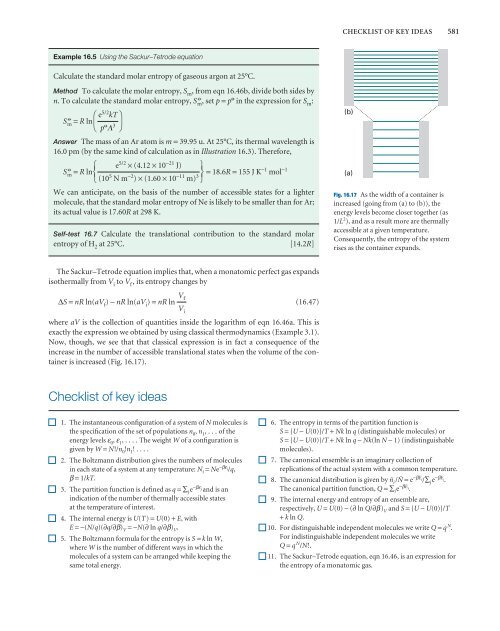Statistical thermodynamics 1: the concepts - W.H. Freeman
Statistical thermodynamics 1: the concepts - W.H. Freeman
Statistical thermodynamics 1: the concepts - W.H. Freeman
You also want an ePaper? Increase the reach of your titles
YUMPU automatically turns print PDFs into web optimized ePapers that Google loves.
PC8eC16 1/26/06 14:34 Page 581<br />
CHECKLIST OF KEY IDEAS 581<br />
Example 16.5 Using <strong>the</strong> Sackur–Tetrode equation<br />
Calculate <strong>the</strong> standard molar entropy of gaseous argon at 25°C.<br />
Method To calculate <strong>the</strong> molar entropy, S m , from eqn 16.46b, divide both sides by<br />
n. To calculate <strong>the</strong> standard molar entropy, Sm 7 , set p = p7 in <strong>the</strong> expression for S m :<br />
Sm 7 = R ln<br />
A e 5/2 kTD<br />
C p 7 Λ 3 F<br />
Answer The mass of an Ar atom is m = 39.95 u. At 25°C, its <strong>the</strong>rmal wavelength is<br />
16.0 pm (by <strong>the</strong> same kind of calculation as in Illustration 16.3). Therefore,<br />
1<br />
Sm 7 = R ln e 5/2 × (4.12 × 10 −21 J) 5<br />
2<br />
67 = 18.6R = 155 J K−1 mol −1<br />
3 (10 5 N m −2 ) × (1.60 × 10 −11 m) 3<br />
We can anticipate, on <strong>the</strong> basis of <strong>the</strong> number of accessible states for a lighter<br />
molecule, that <strong>the</strong> standard molar entropy of Ne is likely to be smaller than for Ar;<br />
its actual value is 17.60R at 298 K.<br />
Self-test 16.7 Calculate <strong>the</strong> translational contribution to <strong>the</strong> standard molar<br />
entropy of H 2 at 25°C.<br />
[14.2R]<br />
The Sackur–Tetrode equation implies that, when a monatomic perfect gas expands<br />
iso<strong>the</strong>rmally from V i to V f , its entropy changes by<br />
V f<br />
∆S = nR ln(aV f ) − nR ln(aV i ) = nR ln (16.47)<br />
V i<br />
where aV is <strong>the</strong> collection of quantities inside <strong>the</strong> logarithm of eqn 16.46a. This is<br />
exactly <strong>the</strong> expression we obtained by using classical <strong><strong>the</strong>rmodynamics</strong> (Example 3.1).<br />
Now, though, we see that that classical expression is in fact a consequence of <strong>the</strong><br />
increase in <strong>the</strong> number of accessible translational states when <strong>the</strong> volume of <strong>the</strong> container<br />
is increased (Fig. 16.17).<br />
(b)<br />
(a)<br />
Fig. 16.17 As <strong>the</strong> width of a container is<br />
increased (going from (a) to (b)), <strong>the</strong><br />
energy levels become closer toge<strong>the</strong>r (as<br />
1/L 2 ), and as a result more are <strong>the</strong>rmally<br />
accessible at a given temperature.<br />
Consequently, <strong>the</strong> entropy of <strong>the</strong> system<br />
rises as <strong>the</strong> container expands.<br />
Checklist of key ideas<br />
1. The instantaneous configuration of a system of N molecules is<br />
<strong>the</strong> specification of <strong>the</strong> set of populations n 0 , n 1 ,...of <strong>the</strong><br />
energy levels ε 0 , ε 1 ,....The weight W of a configuration is<br />
given by W = N!/n 0 !n 1 !....<br />
2. The Boltzmann distribution gives <strong>the</strong> numbers of molecules<br />
in each state of a system at any temperature: N i = Ne −βε i /q,<br />
β = 1/kT.<br />
3. The partition function is defined as q =∑ j e −βε j and is an<br />
indication of <strong>the</strong> number of <strong>the</strong>rmally accessible states<br />
at <strong>the</strong> temperature of interest.<br />
4. The internal energy is U(T) = U(0) + E, with<br />
E =−(N/q)(∂q/∂β) V =−N(∂ ln q/∂β) V .<br />
5. The Boltzmann formula for <strong>the</strong> entropy is S = k ln W,<br />
where W is <strong>the</strong> number of different ways in which <strong>the</strong><br />
molecules of a system can be arranged while keeping <strong>the</strong><br />
same total energy.<br />
6. The entropy in terms of <strong>the</strong> partition function is<br />
S = {U − U(0)}/T + Nk ln q (distinguishable molecules) or<br />
S = {U − U(0)}/T + Nk ln q − Nk(ln N − 1) (indistinguishable<br />
molecules).<br />
7. The canonical ensemble is an imaginary collection of<br />
replications of <strong>the</strong> actual system with a common temperature.<br />
8. The canonical distribution is given by ñ i /Ñ = e −βE i /∑j e −βE j .<br />
The canonical partition function, Q =∑ i e −βE i .<br />
9. The internal energy and entropy of an ensemble are,<br />
respectively, U = U(0) − (∂ ln Q/∂β) V and S = {U − U(0)}/T<br />
+ k ln Q.<br />
10. For distinguishable independent molecules we write Q = q N .<br />
For indistinguishable independent molecules we write<br />
Q = q N /N!.<br />
11. The Sackur–Tetrode equation, eqn 16.46, is an expression for<br />
<strong>the</strong> entropy of a monatomic gas.

















